9 November 2018
We are headed to Cuba today to participate in a Bird Survey (i.e., bird tour) led by the Caribbean Conservation Trust. Being the neurotic person that I am, I wanted to make sure we got to the airport in enough time. We were told to be at the airport by 9:15a.m., for our 12:15 pm flight. Well we got there closer to 8:30 am, so we had a long wait. Fine by me.
At the airport we had to pick up our “tourist visa”, which we had ordered for and paid online. We were told to make sure it is filled out correctly and carry them with us at all times, and most of all “don’t lose them”.
There are only six people on our tour, plus our two guides (one a bird guide, another a local “general” guide) and bus driver (nine total). We will have local bird guides at various points along the way. As for our bird group, we all took the same flight to Cuba, but Erin (she flew a different airline). Jim and Linda, a married couple, are from Florida. Then there is Jeanette, also from Florida. Our bird guide, Michael Good, is from Bar Harbor, Maine. We are all close in age, except for Erin whom I suspect is in her 30s.
I hate flying, especially take offs. To me every time we take off the plane sounds different (well duh, they are different planes), so if something doesn’t sound right I get nervous. On the other hand, most people don’t like the landings. This was evident when most of the people on the plane clapped when we landed. The landing seemed normal to me, although we did come in a little fast.
We exited the plane in Cuba and immediate got hit by a wall of heat and humidity. Ugh, we really don’t like the humidity. The Floridians like to say, “Oh, you get used to to it,” — I don’t think so. Luckily we don’t have to worry about humidity in Alaska.
We all went through immigration – the typical frown and cursory check, without any problem, picked up our luggage, and then went over to another terminal to pick up our last fellow birder, Erin from Vermont. Erin is both the youngest and the newest birder. Nice to have a fun, young person on the survey.
And yes, the pictures/images of Cuba are true, we saw a lot of old classic cars, but the Russian-made taxis were quite new. We got into our vehicle (a bus) to begin the bird survey and headed west to the valley of Vinales, about three hours away. This is a beautiful area, with lots of limestone cliffs and cave formations. We stopped off at one cave near our hotel where thousands of bats emerge each evening. Unfortunately, we got there a little late and only saw a few of the bats.
We spent the night at Rancho San Vicente, just outside of the town of Vinales. After dinner Michael, Erin, Jeannette, Jack and I tried to locate and see a Bare-legged Owl (formerly the Cuban Screech Owl). We heard it several times, but never did see the bird. And we were like yo-yos going from one side of the road to the other to avoid the traffic on the road, which wasn’t much but it was constant and it was Friday night. Erin befriended a local dog and it decided to follow us around. I’m not sure what role dogs have in Cuban life. They don’t seem to be pets, nor do they seem to be service animals. I do know many are starving and we saw some with mange. Poor things. These dogs definitely lost out in the lottery.

Cuban Tree Frog – look closely as it is great at camouflage. It also jumped on my leg causing a scream to come out of my mouth. The frog is harmless.

Dwarf Boa Constrictor
10 November 2018
We spent the first part of the morning birding around the hotel, mostly because there were just so many birds right out our back door: Cuban Pewee, West Indian Woodpecker, Cuban Trogon, Red-legged Thrush, Great Lizard Cuckoo, Olive-capped Warbler, Scaly-naped Pigeon, Cuban Solitaire to name a few. We always seem to find more birds near our hotels and parking lots…go figure.

Cuban Trogon

Great Lizard Cuckoo

Olive-capped Warbler

Cuban Pewee

Scaly-naped Pigeon
We then went to a nearby farm (Finca) to bird, which also proved productive, We got great looks at the Cuban Tody, a bird I was really hoping to see on this trip. Luckily it is a common endemic species. What a beautiful, colorful, small, charismatic bird.

Loggerhead Kingbird

Termite mound

West Indian Woodpecker



Next we went to a park to look for “grassquits”, finding the Yellow-faced Grassquit, but only hearing the Cuban Grassquit. Hopefully we will see this bird species tomorrow. I heard a noise that sounded like a pig, and it turned out that’s what it was – a pig. Well actually several pigs. If farmers can’t afford to feed their pigs, they let them loose. Unfortunately, the pigs cause a lot of damage to the environment. While they were quite close, they essentially ignored us.


Alligator Lizard


Great Lizard Cuckoo


Cuban Bullfinch
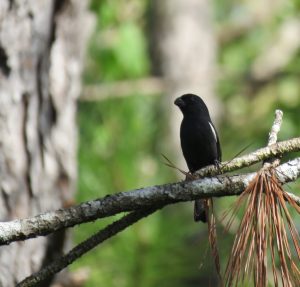

Cuban Tree Frog


Searching for the grassquits







We had a late lunch at a Farm to Table restaurant. The produce is grown on the Finca. It was yummy. We had beautiful views of the Vinales Valley and the surrounding mountains (limestone Karst).


Some interesting signs – what you can do and what you can’t do


Lots of horse drawn carts

The Farm to Table restaurant

View from the restaurant of the Vinales Valley


Sadly we then left the Vinales area and headed to the town of San Diego de Banos for the night. After checking in we walked around town searching for birds. We came to an area and played the call for the Cuban Pygmy Owl. The owl responded a number of times, flying from one side of the road to another. However, each time it flew into dense vegetation, and the only sightings we had of the bird was as it darted across the road – fast. If I didn’t hear the bird call, I couldn’t say it was an owl that flew across the road. Maybe we will get another chance to see the bird. I hope so.


Interesting wire job





View from our hotel room balcony

View from our hotel room balcony

At dinner we had a Cuban band serenade us. Our bird guide said they were better than last year, and Jack thought they weren’t good at all. They weren’t bad and they made up for their loudness with their enthusiasm. They had CDs to sell, but no takers from our table.
11 November 2018
After breakfast we headed to Hacienda Cortina to look for the Giant Kingbird, which we did find along with other great bird species including the Tawny-shouldered Blackbird, a Cuban endemic (which means it is only found in Cuba). I’ve been trying to actually see the “tawny” shoulder patch on this bird as we’ve only seen the bird flying and at a distance. From a distance it could be mistaken for a Cuban Blackbird (if you are new to Cuban birds). The birds flew into a tree and as they were landing with their wings outstretched I could actually see the “tawny” color. We got good views of the Giant Kingbird despite the fact that two Loggerhead Kingbirds kept harassing it.

Giant Kingbird

Cuban Trogon

Cuban Tody

American Kestrel

Emerald Hummingbird

Red-legged Thrush

Louisiana Waterthrush

Western Spindalis

This guy is off to get water …


… and now he is sitting on the barrel after procuring water

Red-legged Thrush


This Hacienda was once owned by a wealthy Cuban. It fell into disrepair and is slowly being fixed up with carriage trails, ponds, and landscaping – a very pleasant place. The general public is allowed to visit the Hacienda, including us birders.
We then went to a field to check for grassquits, primarily the Cuban Grassquit. But alas all we found were Yellow-faced Grassquits. We saw these yesterday, and they are not a new bird for me, although I haven’t seen them in some years. These birds can be found in Central and South America. They feed on grass seeds, but are generally seen on brush/bushes.

Raking rice on the road
Since we didn’t see the Cuban Grassquit yet, we had another chance at a finca (farm) about 50 km away. So we went. Someone associated with the farm put out some crushed corn attracting both the Cuban and the Yellow-faced Grassquits, resulting in great views and many birds. In order to get good looks (and photos) of the grassquits we had to run off the competing Helmeted Guineafowl and Domesticated Wild Turkeys attracted to the feed.

Cuban Grassquit – male

Fresh from the grassquit success, we headed to Playa Larga on the Zapata Peninsula – our location for the next two full days of birding and more ‘target’ birds (endemics). Playa Larga is a five-hour drive away. A long bus ride, but a good chance to check out the countryside, including the various houses. We did make one stop at a lake to check out the birds. We saw hundreds of ducks and Pied-billed Grebes.




This dog broke my heart
We arrived in Playa Larga, which is situated on the infamous Bay of Pigs, after dark – around 6:30 pm. The rooms here are in a local hostel. In Cuba, hostels are owned by private citizens whereas hotels are owned by the government. Our local guide said the government hotels offer less services than the private hostels. Our hostel – Hostel El Enrique – is quite nice. We’ve stayed at three different places so far and this is the nicest one yet.

Our room at El Enrique. Each room was decorated differently.

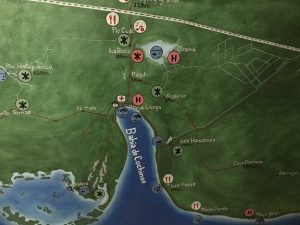
12 November 2018
We got an early start – 6:15 am – so we could get to a nearby bird blind early to check out the endemic quail-doves. We got to the bird blind and immediately saw three of our target species: Gray-fronted Quail Dove, Blue-Headed Quail Dove, and Zenaida Dove. The Blue-headed Quail Dove was a favorite with its quite striking blue head as the name implies. From there we went in search of the Bee Hummingbird – think small…very small.


Birding Blind

Checking out the doves and other birds


Our local guide Frank





The Bee Hummingbird, is believed to be the smallest bird in the world at 2.0-2.4 inches from tip to tail. As it was quite hot outside, it was a challenge to pursue this bird. This bird of course likes flower nectar, so we’re in search of its favored flowers. The bird was spotted first by Erin, who is quite the bird finder (or whisperer if you like). But the bird darted off. We then stood in what little shade we could find, sweat pouring down our faces, and waited and waited for it to buzz back. We were finally rewarded when a female Bee Hummingbird made her appearance for the rest of us. We got some good looks at the bird before it flew off to find nectar elsewhere. We then retreated to a local museum in the town of Playa Giron; the museum was dedicated to the Bay of Pigs mercenary invasion (Cuban term) in 1961. Not one of U.S.A. (C.I.A.) finest moments.




Another one of our local guides – here looking for the Bee Hummingbird
After visiting the museum, we went to an area where we could go swimming in the ocean if we so chose. Jack, Erin, and Jeannette either dawned their swimsuits (okay only Erin) or went in to the water in their clothes (Jack and Jeanette). It was a beautiful area, and there were plenty of tourists, including one who was topless. Jack, Erin, and Jeanette looked like they were having fun. This area is part of a coral reef, so the swim area was protected from the open ocean.

Greater Antillian Grackle …

… hoping to get fed

And dogs are anywhere there is food. Can’t say that I blame them.


A pool where you can swim. Supposedly it connects to the ocean via a tunnel.

Lots of fish

Erin swimming

Erin and our local guide Abel

Brain coral

Was told this is a 1957 Ford

The water does look inviting
We then went back to the hotel for a little down time in our air conditioned room. Some of us walked around town and birded. Jack stayed back and cooled off. Then around 4:45 pm we took off in search of the Cuban Parrot, Cuban Parakeet, Fernandina Flicker, and the Cuban Nightjar. For today and tomorrow we have the benefit of a local guide – Frank – who happens to be the director of the Zapata National Park. He got us on the Flicker, the Parrot, the Parakeet, and the Nightjar. At one point, we even had the Flicker and the Parrot in the same tree. The local guides are amazing.





View of Playa Larga from our hostel

American Kestrel



Cuban Parrot

Cuban Nightjar
With darkness descending, we left the area and returned to our hotel for dinner.
13 November 2018
Today was another early morning with breakfast at 5:45 am and on the bus by 6:15 am. We made our way down a one-way road, of sorts, into the heart of the Zapata Swamp (a huge area) in search of two elusive endemic species: Zapata Sparrow and Zapata Wren. We got to see the Zapata Sparrow within about 10 minutes of arriving at our destination. The Zapata Wren, however, remained elusive, except for Erin who was lucky enough to see the wren at a location we had just vacated. I had so wanted to see this secretive species. One of my favorite bird families are wrens. To get to this location we had to drive a single lane dirt road with only one turnaround about 5 miles down the road. And we had a huge bus. Kudos to our driver Carlos. He has been a fabulous, very safe driver, and so friendly despite not speaking English.

The road into the swamp

This was the only area for a bus to turn around. Luckily our bus wasn’t any bigger. There is maybe five feet on either end of the bus.



Somewhere in all that grass is a Zapata Wren


Cuban Green Woodpecker

Cuban Green Woodpecker


Green Heron

This ‘headless’ Boa Constrictor was on the road

The snake had a beautiful blue/green sheen

We made a stop at a fish farm to search for a Wattled Jacana. At this fish farm they raise Cuban Gar for conservation purposes, not for eating as people don’t eat Gar. The Gar is considered a prehistoric species, having been around since Cuban came into existence over 40.0 million years ago (or so we were told). Oh, and we didn’t see the jacana.

From there we went to a private residence, Casa del ZunZun. The homeowners have feeders and bird-friendly plants and allow people to come into their ‘aviary’ to experience the birds that flock there like Bee Hummingbird, Emerald Hummingbird, Black-throated Blue Warbler, Tawny-shouldered Blackbird, and Cuban Oriole. At least that is what I saw while there. Lots of great opportunities to take photos of these birds. The Bee Hummer was a great find.


Desmarest’s hutia. I thought this little guy was cute. Jack, not so much.

Cuban Oriole (black with with yellow on its wings)

Tawny-shouldered Blackbird

Black-throated Blue Warbler


Bee Hummingbird

Bee Hummingbird
Our final stop of the day was to Las Salinas Wildlife Refuge. Wow!!! What a fantastic place, which is part of the Zapata Swamp National Park. Lots of water so there were waterbirds everywhere and we got to see hundreds of American Flamingos – beautiful. These birds were almost as pink as the iconic plastic flamingos you see on people’s lawns. We also had a good look at a perched Cuban Pygmy Owl, which previously we had only see as a night fly-by and they fly-by quickly. There were herons, egrets, pelicans, cormorants, terns, gulls, osprey, kingfishers, and even a Clapper Rail, which is always special to see.

American Flamingo


Crab in the water


Tricolored Heron


Along the road were several viewing platforms



Brown Pelicans and Cormorants (Neotropical and Double-crested)

Magnificent Frigatebird

Clapper Rail


Cuban Pygmy Owl
14 November 2018
Today was primarily a travel day as we made our way from Playa Larga to Cayo Coco. We did make a few stops along the way for bathroom breaks (it costs money to go to the bathroom – 25 cents), for lunch (all you can eat buffet, although there wasn’t that much to eat), and to check out a fish pond for birds.

This area was near the fish pond


Apartment building in Cuba – many were Russian styled
We then traveled over a causeway, which is about ten miles long to our destination for the night – Melia Cayo Coco hotel. This is a big resort-style hotel. We are in an eight-plex building near the beach. Of course we will probably be too busy birding to enjoy the beautiful beach and beckoning blue ocean.
Once we crossed the causeway to reach the Cayo, there were hundreds of waterbirds, including a large flock of Black-necked Stilts estimated at around two hundred. As we neared our hotel for the night, we saw about nine West Indian Whistling Ducks standing on a small dock. Nearby was a Juvenile and an adult Yellow-crowned Night-Heron. The whistling duck was a life bird for us and a bird I really wanted to see. Woohoo!!!
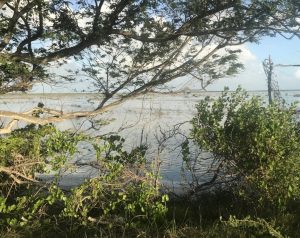


Reddish Egret

Tricolored Heron

Egrets and Herons
The hotel complex we are staying at is huge. They have five different restaurants, three of which require reservations. We went to a non-reservation restaurant that had a huge buffet. Lots of great food to choice from. And a great dessert bar! This is an all inclusive hotel, which means all food and beverages are included in the cost. So you can eat a little or a lot, drink a little or a lot. It doesn’t matter. The food variety and quality was very good. We’ve not taken a cruise before (other than on a small boat to Antarctica), but this is what we imagine it to be like.

West Indian Whistling Duck



Yellow-crowned Night-Heron

Afterwards several of us went in search of a Barn Owl, but we suspect the owl either left before, or died during, Hurricane Irma last year (2017). When we came back to our room there was really loud music playing next to our accommodations, of course. I think I’m cursed by the music gods. With ear plugs in, I could still hear the music, although not as loud . Luckily I was tired and fell right to sleep, thank goodness.
15 November 2018
We got an early start – in the lobby at 5:45 am for coffee and pastries, then on the bus for more birding. The target birds for the day were: Oriente Warbler, Cuban Gnatcatcher, Thick-billed Vireo, and Bahama Mockingbird. We scored three of the four birds. The only bird missing was the Thick-billed Vireo – a localized species so very susceptible to hurricane disturbance. Our guide knows of only two recent sightings of this bird – both last fall- shortly after the Hurricane. This part of Cuba was hard hit by Hurricane Irma.
I think my new favorite warbler is the Oriente Warbler. This is a pretty gray and yellow bird. When we first saw the bird it was out in the open for some time. Of course it was the one time I did not have my camera with me. I told everyone they can thank me for not bringing my camera.







Julia (butterfly)

Zapata Sparrow

Cape May Warbler

Juvenile Cape May Warbler

Cuban Green Woodpecker
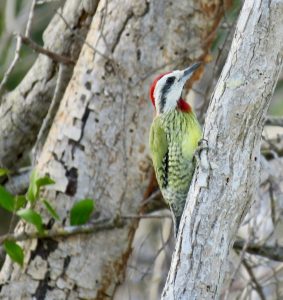



We then spent the next several hours at various places on Cayo Coco, Cayo Paredon Grande, and Cayo Romano in search of the vireo and gnatcatcher. While searching for those birds I happened upon the Bahama Mockingbird. I was walking down this road and something made me turn and look slightly behind me on the left. There, sitting silently in a bush, was a large bird that looked to be a mockingbird. Now the Northern Mockingbird is in Cuba too, but this bird was just too large to be a NOMO, as Jack and I call the Northern Mockingbird. Plus the bird had streaking on the chest, which the NOMO lacks here. I was sooooo happy to see this bird. Another life bird for me.

Bahama Mockingbird


Searching for the elusive Thick-billed Vireo


We had one more stop to make, in search of the Cuban Gnatcatcher, before heading back to the hotel for lunch. At this last stop we finally found the gnatcatcher and got good looks at the bird. Another lifer. While looking at this bird, we had a Cuban Black Hawk in a nearby tree posing, and a Mangrove Cuckoo. Jack and I’ve only seen the Mangrove Cuckoo once before in Panama back in 2008. Nice to see the bird again.

Cuban Black Hawk – this bird’s call is “Ba-Ti-Sta” I guess these birds are waiting for Batista to return to Cuba.

Mangrove Cuckoo

Cuban Gnatcatcher

Lesser Black-backed Gull
There is a lot of evidence of impacts to the island’s vegetation – a lot of downed trees – as a result of the Hurricane last year. There isn’t much development on these Cayos (a term meaning island) except for hotels but there are a lot of hotels and more being built. I can see why they’ve built hotels on Cayo Coco as the water here is a beautiful turquoise blue. However, I’m not one to spend my entire vacation sitting around a pool or the beach and just eating and drinking and swimming and sunning. I’d rather be birding.



Here you can see part of the old road – what’s left after the hurricane
Lunch was amazing. So much food to chose from. If I stayed here a week I would probably gain 20 pounds or more. Good it is only two nights. I wonder what they serve for breakfast. We missed the buffet breakfast this morning in order to bird. And I love to go out for breakfast.
We got a couple of hours off, and Jack and I spent part of that time with Jeannette who is a hoot. She always good for funny life stories as a labor organizer.

Our 8-plex building – we were in the upper right hand corner room. Great views of the ocean and beach.

View from our room

They did have a great beach

This turtle was hanging out in a small water feature on the hotel grounds
In the late-afternoon we headed back out into the heat, although the humidity here doesn’t seem as bad as when we we’re further inland or along the western coastline. At least not to me. We went to look for shorebirds, but too much high water. We only found a few Black-bellied Plover, Sanderling, and Ruddy Turnstone. Still, glad we got to see some shorebirds. I love my shorebirds.

We spotted a few shorebirds along the beach
Next we drove out to Cayo Gulliermo to search once again for the Bahama Mockingbird. Not everyone got as good a look as yours truly. We didn’t find the mockingbird. The area where it had been seen in previous years was now bull dozed over and a large hotel was being constructed. However, we did get good views of a Yellow-billed Cuckoo.
On the way back to the hotel, we stopped at a bridge that had three statutes of Ernest Hemmingway. He wrote “Islands in the Stream” while he was in Cuba. At the bridge, we waited about 20 minutes for the sun to set and watched several locals fishing from the bridge. It was a beautiful sunset.

Yellow-billed Cuckoo


Juvenile American Flamingos

Laughing Gull

I just love the color of the water


Jack with Hemmingway

Local Fisherman with his “Needle” fish catch

The Needle Fish is silver and green – beautiful








Hard to believe we’ve been here for a week and only have three full days left. Tomorrow we leave Cayo Coco and head southwest. Need to find the Palm Crow.
16 January 2018
In the early morning (around 6:30 a.m.), we went to an area with a cave bar that can hold up to 400 people. Not my idea of a good time, but to each his/her own. We birded near the cave as the caretaker keeps feeders and water out for the birds. The target bird was the Key West Quail Dove. Unfortunately, it was a no-show. We did however, get to see my new favorite warbler – the Oriente Warbler. Too bad this bird is an endemic. If I want to see it again I have to come back to Cuba. We also got good looks again at the Zapata Sparrow. This bird too is an endemic. We had two within ten feet of us feeding all around some old equipment. We did get a new bird for the trip (but not a new life bird) – the Painted Bunting. It was a female, so all green. The male is a beautiful green/blue/red bird. Our guide, Michael Good, said he has only seen a male Painted Bunting once in Cuba and it was in a cage. Yes, there is the illegal capture of birds for the pet trade. So sad. I’m not a fan of keeping birds in cages.

Ovenbird

Zapata Sparrow

Cuban Grassquit

Cuban Tody



Oriente Warbler …

… my new favorite warbler


Yellow-throated Warbler

Erin loving on a local dog

Looking down into the cave bar

La Sagra’s Flycatcher

We then went to a pond to look for some new birds, but just saw some old favorites: Greater Yellowleg, Green Heron, Belted Kingfisher to name a few. In all, I had 35 species for the two hours we were out birding.
Okay remember I said I was looking forward to breakfast at the hotel we were staying at? Well we returned from our early-morning birding excursion to the buffet line. I was sorely disappointed in the breakfast buffet. Oh well.
After breakfast we hung out at the resort. The plan was to check out at noon, have lunch at the hotel, and then head to our next destination – Sancti Spiritus (a town and Province) and our accommodations at Rancho Hatuey.

Near our hotel


This guy was spear fishing. He had at least 3-4 different fish species.


The trip to Sancti Spiritus should have taken us around 3 hours, but it turned into an almost five hour bus ride. Our driver and local guide were using a GPS. The GPS gave our driver directions for the shortest route. Now the shortest route does not always mean the fast route, which we found out later. The road was not paved and we were suddenly thrown back in time about 50-60 years. Our local guide told us this is the real Cuba. Many of the people we saw from the bus looked at our bus in bewilderment. We were all happy to have taken this route, however, because we went through a very beautiful part of Cuba – the real Cuba.

Our guide Michael sleeping on the bus
We arrived at our hotel after dark and had about 30 minutes to get ready for dinner. Dinner was nothing special and neither was the room. The only redeeming feature was the comfortable bed. Many of the beds we’ve had have been hard – like sleeping on the floor. This was my least favorite place to stay on the trip, despite going to bed early and getting a good night’s sleep.
17 November 2018
We birded the hotel grounds and surrounding area prior to breakfast at 7:30 am. Following breakfast, we headed towards Trinidad, a historic Spanish colonial city. Trinidad was once the center of commerce and wealth, but is now a tourist destination. We walked to the main plaza but the very narrow streets limited our bus adventure. Luckily, vehicle traffic is not very congested in Cuba as it costs a great deal to import/purchase a vehicle, thus, many classic 1950s vehicles are inherited and have very high value. The ’55 and ’56 Chevy were very common, never did see a ’57 Chevy (only a ’57 Ford).
En route to Trinidad, we made several stops in search of the Palm Crow and the Cuban race of the Eastern Meadowlark. The Palm Crow is a near endemic (Caribbean species) and the Eastern Meadowlark may become its own Cuban species soon. So we wanted to be sure we got to see both birds. The first stop proved fruitless for either bird. The second stop we did see at least two Eastern Meadowlarks. As we were walking back down the road from which we came, we heard the Palm Crow calling. We saw a large flock of crows, however, there were also Cuban Crows in the area and what we saw could have been them too. No way to know for sure which bird we were seeing, as the best way to distinguish between the two birds is through their calls. We tried chasing the large flock of crows, but only heard and saw the Cuban Crow. We needed to get moving so we called the hearing of the Palm Crow as good. Off to Trinidad.

Passionflower

Various modes of transportation in Cuba

American Kestrel – many of the birds here have crisp white chests


Cuban race of the Eastern Meadowlark






This guy was following a man riding a horse. They were both carrying water.

Some of the various houses



Upon arrival in Trinidad we spent about 45-60 minutes walking around the town. Our local guide is also a general guide and knows a lot about the history of Cuba. Jack was more attentive than I. I’m more interested in the birds. What was most distressing about the town were the caged birds. Our guide tried to free a caged Cuban Bullfinch, but was unable to open the door. As Jeannette said, you can’t change stupid people.




A lot of the souvenirs were repetitious. If you didn’t buy what you wanted in the first shop, there were many more shops with the same items.

Cobble streets – not easy to walk on


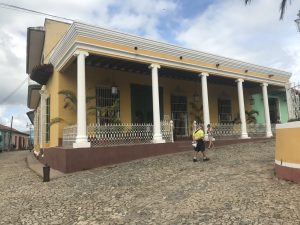






These musicians were playing the famous Cuban song “Guantanmamera”. Our guide said the title sounds like “One Buccanero” (which is one of the local Cuban beers).

And this guy was dancing to the music



Buggy ride anyone?



Erin was the only one to buy anything in Trinidad


The caged Cuban Bullfinch that Michael tried to free
After Trinidad we drove to Cienfeugos, a town on the coast, for lunch. Lunch was good. I decided to have chicken instead of pork as I’ve eaten a lot of pork on this trip. I thought maybe I could have pork for dinner. Wrong. Pork wasn’t on the menu. Darn. So an evening meal of chicken it was. We had a late lunch, and even though dinner was late (around 8:00 p.m. or so), I didn’t eat much of my meal. I am not used to eating so late in the evening and I so hate wasting food.

They do paint them various colors. I doubt this is the original color.
The bed at our hotel, Los Maletas, is again hard as a rock, but the pillows are acceptable. We are in an old building in the heart of Old Havana. Tomorrow we put birding aside to go for a walking tour of the historic center of Havana, then visit Cuban naturalist Senor Orlando Garrido.

Looking down from our hotel room into an open patio area

A church near our restaurant. I suspect that the guides get a kickback for bringing tourists to a particular restaurant or hostel.
18 November 2018
Today we spend the morning walking around Old Havana, its surrounding fortress wall, and learning about the different majestic government buildings, museums, churches, and plazas, including the hotel made famous by Ernest Hemmingway. Today is Sunday, so lots of families out and about. The Havana waterfront has an extensive walkway so a very pleasant stroll. Plus, lots of tourists since there are two very large tour cruise ships in port. The tourists bring out the street musicians, mimes, and hawkers.









This was a homeless guy who enjoyed talking to himself

All dressed up …



Jeanette gave this guy a few coins and in return he threw a chain around her neck and tried to take her head off. All in fun.




Erin said “Look a phone”, and then this woman went over to pick up the phone and listen and then check to see of any money was in the coin return slot.

Narrow streets in Old Havana



A very nice park in Old Havana


Castillo de la Real Fuerza – supposedly the oldest building in Havana. There is an actual “moat”.


Jack crossing the moat





Rock Pigeon


Eurasian Collared-Dove








Yes, it actually works

Havana Cathedral, or La Catedral de la Virgen María de la Concepción Inmaculada de La Ha


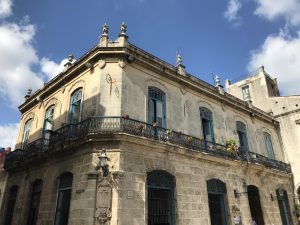

One of two cruise ships visiting Havana. No wonder the streets seemed crowded with tourists.

Our birding group





Lots of street performers

This was painted on a wall across the street from our hostel


We got to see a lot of the old cars while in Cuba, and in Havana some of them are now taxis. Many have changed the color of their cars – some are hot pink. We actually got to ride in old convertible cars on our way to dinner. I was afraid the car we were riding in was going to break down, either that or run out of gas. There are other modes of transportation in Cuba too – bicycles, wagons, carriages, horses, newer cars, buses, trucks (passengers standing up in the back), and trucks converted to transport people. I cringe when I see these trucks because the people are not protected at all should the vehicle get in an accident and roll.



This seems to be a popular color





Now I like the color of this old car, which is now a taxi




Jim, Linda, and Michael in their old car on the way to dinner

Now this was a little scary. Our driver was working the phone most of the trip.
We had a pleasant visit with Senor Orlando Garrido. He is quite the character. He told us stories about his tennis days (he played at Wimbledon and in the Davis Cup), and he is famous for developing a Cuban field guide. He admonished us to verify birds we were observing (Osprey and Northern Flicker) and how they might soon become recognized as separate species. We didn’t see the Northern Flicker, but we did see the Osprey. However, we didn’t look closely enough at the bird (generally seen in-flight) to tell the difference between the Cuban and the North American Osprey races.

Senor Orlando Garrido

The Zapata Wren I didn’t get to see
Tomorrow we head home to the United States. We had a very good time in Cuba and give it high marks. Cuba is an interesting country and the people are very friendly – no anti-American sentiment (they love Obama!). I do have an issue with how they treat their dogs nor do I Iike caging of birds. While Cubans get free medical and a free education, price controls on imported items and cars are expensive or prohibitive. The internet is very limited, but cell phones are common ($5/month fee!). Food at restaurants was expensive too. Similar to American prices.
19 November 2018
We left for the airport and got to see a lot more of Havana. The flight to Florida was uneventful. I think we spent more time on the ground waiting to take off (started loading 55 minutes before the flight was due to take off) than in the air (48 minutes). I like these short trips.
I would recommend Cuba as a birding destination. Of the 26 Cuban endemics, we got them all except for Zapata Wren, Zapata Rail, and Cuban Kite. Not too shabby. Plus, we got a number of the near endemics as well. I am a happy birder.










































































































































































































































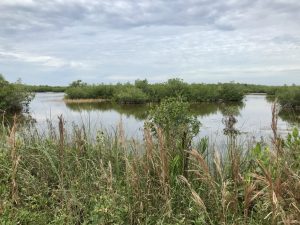









































































































Recent Comments